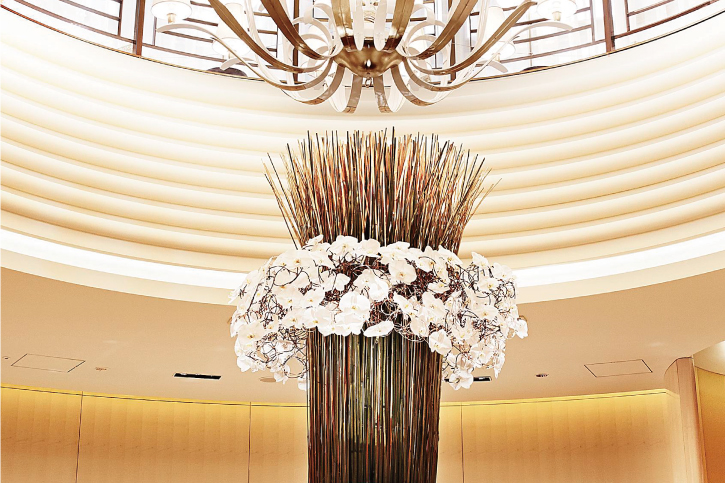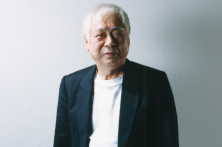Having resided in Paris for many years, I have of course sampled the offerings of Parisian restaurants. Yet I have also dined at restaurants the length and breadth of the country—a countless number, indeed, of Michelin-starred establishments and nameless kitchens. Some left powerful impressions ...MORE

Enjoy the columns featuring stories related to L’Osier, as well as the food culture and the cuisine.
Beneath the vast atrium, as if in a small garden, or perhaps a forest, flowers track the changes of the seasons and enrich the environment with life. Responsible for these floral decorations is the Belgian flower artist - also known as the “flower architect” - Daniel Ost. My relationship ...MORE
The redesign of L'Osier's logo was entrusted to Masayoshi Nakajo, a designer cut from the cloth of Shiseido's own advertising department. Even after he became an independent designer Nakajo held true to Shiseido's corporate philosophy, and this has led to a long-lasting partnership between ...MORE
As L’Osier prepared for its rebirth, we employed the services of the acclaimed designer Pierre-Yves Rochon. From the remodeling of a building in Florence that was a 15th-century palace, to styles that incorporate modern forms—Rochon creates unique appearances that are perfect for the world’s ...MORE
In general, the finest eateries, grandes maisons, can be defined thus: three Michelin stars; establishments with history; the highest standards of cooking; distinctive interior decor; flawless service; Chefs renowned as Un des Meilleurs Ouvriers de France; and mouth-watering wine lists.
Some establishments of quality are cocooned in layers of history and exude a unique ambience. With their gorgeous interiors, they seduce patrons into a space where the normality of everyday life is forced aside—a space where luxury and sophistication is to be found in every corner. From the moment one enters until the final morsel is consumed, patrons swoon at the pleasure of the occasion, and at the privilege bestowed.
Sophisticated, exquisitely prepared cuisine beckons one into a world of culinary beauty. Wine, gorgeous cutlery, and splendid interior decorations are the delightful companions on this gustatory journey. High ceilings playfully echo patrons' conversations. The sounds of uncorked bottles and popping champagne sing a background melody. The clinking of cutlery on plates provides the percussion for a symphony sustained by distinguished service from the maitre d'hotel and the other staff. In such idyllic harmony, the appetite is whetted. And the climax: the restaurant metamorphoses into a space of pure delight.
L'Osier provides the very cuisine, the very space, the very time so highly esteemed in the grandes maisons of France. Thrilled by cuisine and by service, enveloped by a classy clientele, and bathed in the gentle bustle of friendly conversation, L'Osier is the one and only establishment in Japan, where the delights and the espirit of French cuisine can be tasted. Cast aside the restless worries of daily life, and sample bliss at the diamond in the cultural crown of Tokyo: L'Osier.
Satoru Udagawa
Born in Tokyo in 1947, Udagawa studied politics and economics at Waseda University. He is a writer who has received a number of prizes, including the French government's prestigious Chevalier de l'Ordre de Merite Agricole. His works include VAN Stories (Van Stories), Oshu Media no kobo (The rise and fall of European media), Ryorinin no topparyoku (The penetrative power of chefs), Hotel Okura Soryoricho Ono Masayoshi (Masayoshi Ono—executive chef at the Hotel Okura).

My relationship with Shiseido stems from 2005, when I was invited to design the Christmas decorations at the Tokyo Ginza Shiseido Building. I was granted the freedom to express myself and create elegant artworks, and I count it as one of the most rewarding experiences of my life as an artist. In the past, I have had, of course, occasion to compose floral artworks at special banquets. Yet, this is the first time that I have undertaken to decorate one restaurant continuously with flowers. I would not have done so were it not for the mutual trust I share with Shiseido.
When creating my floral decorations for L’Osier, I place great importance on how they will interact with the restaurant’s impressive architectural space. In the present incarnation of L’Osier, an art deco interior is imbued with that particular “Shiseido quality.” There is an emphasis on light rather than shadow and darkness, and the vaulted ceilings convey the sense of grand space. In my private shows, it has typically been my experience that I am “inserting” my artworks into the exhibition spaces. What I give utmost consideration to at L’Osier, however, is how the architecture and the artwork can coexist in a symbiotic relationship. This was especially true of last year’s opening, where I exhibited a creation of bamboo and cymbidia. The balance between artwork and architecture was just right, and the result was a fusion of Eastern and Western sensibilities. It is something I cannot forget.
Having said that, for guests the most important aspect of the L’Osier experience is surely what arrives on the plate. So, while the decorations in the center of the restaurant space exude presence, on each table is also placed a small selection of flowers in a vase by Anna Torfs, a Belgian designer as yet little known in Japan. It’s quite a coincidence, but the champagne bubble design seen throughout the restaurant and the bubbles trapped in the glass designs of her vases match perfectly—it’s rather moving.
Nowadays, there is an increasing tendency all over the world to use artificial flowers. I don’t know what will happen in Japan in the future. But, since it is the country which, longer than any other, has evinced a close relationship between flowers and people through the practice of “Ikebana,” I think there is more hope for Japan than for the West. For this reason, I hope that one day L’Osier will create a specialist position, much like a sommelier, whose sole duty is to tend to the flowers in the restaurant every day.
Daniel Ost
Born in 1955 in Saint-Nicolas, Belgium. Beginning from his twenties, Ost has won a number of international competitions. In 1990, he received the gold medal at the International Garden and Greenery Exposition in Osaka, Japan. Ost has exhibited his floral creations at traditional architectural structures throughout the world. In Japan, these locations include Ninna-ji, To-ji, Kinkaku-ji (the Golden Temple), and Izumo-taisha (the Izumo Grand Shrine).
The art nouveau logo that adorned the old L'Osier from 1973 to 1997 was the creation of Shiseido advertising department's Makoto Nakamura; the logo that crowned the art deco redesign of the shop from 1999 to 2011 was overseen by Akio Miyake, also of Shiseido advertising department.
Prior to this project, I was artistic director for The Ginza and TACTICS DESIGN(Shiseido cosmetic brand), and I had supervised both the logos and package designs for Shiseido Parlour, but I had not had any direct experience with L'Osier. However, I did have a sense that the 1973 logo was perhaps altogether unbalanced, and I was aware that the new L'Osier would no longer be art deco. So, of my own accord, knowing that L'Osier's redecoration was to be complete in 2013, I set about creating a new logo. With great eagerness I showed this to the staff but their response was:“No. The logo must remain fundamentally the same. It is only to be modified in part.” While I felt uneasy playing with someone else's design, Miyake had himself said before he retired,“If the logo is to be altered, let Nakajo do it.” And so I became involved.
It's a peculiar thing, but a logo begins to age if it is left in its original state. The essence of design is“change”; in fact, a design can only be regarded as complete in so far as it changes. For the new L'Osier logo, then, I decided to make the typeface slightly wider and to narrow the space between the letters, and so give it a more modern feeling. Western typography has various rules: for example, letters with lots of curves such as“O” and“Q”appear slightly smaller than other letters of the same size, and so are typically enlarged; another common feature is that horizontal lines are slender, and vertical lines thick. But, of course, we are Japanese; and so there is no need to follow all these rules to the letter. Indeed, I think it a good thing if the logo can be made to‘feel’Japanese. So, I made the horizontal lines in the L'Osier logo just slightly thinner, but the“O” looks small—or rather, I prefer“O”s to look small, so I let them be.
In the present day and age, when computers and smartphones and other types of media are proliferating, it is more important than ever to have a well-designed logo. And yet, examples abound of gimmicky designs masquerading as refinement, or of delicate script overlaid with silver or gold leaf, or of all-black designs. But these do not touch our hearts:“elegance”is not so weak. The redesign of the L'Osier logo harks back to the time of Shiseido's camellia flower, Hanatsubuki, since when the notion of“elegance”remains unchanged.
Masayoshi Nakajo
Born in Tokyo, Japan, in 1933. Nakajo graduated from the Tokyo National University of Fine Arts and Music (now Tokyo University of the Arts), where he majored in design, and joined the Shiseido advertising department in 1956. He left Shiseido after three years and joined DESKA (Designers Kono Associates). In 1960, he struck out as a freelance designer and, the following year, he founded Nakajo Design Office. Nakajo has won numerous awards including the ADC Award, the Mainichi Design Prize, and Yusaku Kamekura Design Award. In 1998, he was awarded the Medal with Purple Ribbon by the Japanese government.
Pierre-Yves Rochon
Born in the Brittany region of France in 1949. Rochon established Pierre-Yves Rochon, Inc., an interior design firm, in 1979. The firm currently has offices in Paris and Chicago. Rochon has worked on a wide range of projects, including five-star hotels—such as the Four Seasons Hotel George V, Paris, The Savoy in London, and Four Seasons Hotel Firenze—restaurants, and private residences.
When I take part in projects to create restaurants inside large buildings, there are ways in which the restaurant is unavoidably restricted by the scale of the building. The major issue for the design of L’Osier was how to handle the fact that it is situated on an underground floor—an unusual location for a high-class restaurant. But in the end, I think this location proved to not be a shortcoming at all. There is a circular floor in the center of the mostly square building. By making this round portion into an atrium, we were able to double the volume of the room and make people forget that they are dining on an underground floor. Guests will be drawn into an entirely different world as they take step inside from the front entrance. As they descend the stairs around the circular atrium, the venue will gradually expand into a roomy space that belongs entirely to the guests—that’s the kind of experience that L’Osier offers.
In a place like this, the most important thing is the expression of quality. We make meticulous adjustments to countless detailed elements so that guests can enjoy their visit in a comfortable, relaxed fashion. To me, Shiseido evokes a modern yet somehow classic image, so I thought about how to combine these two aspects into the interior design. It features warm white, bronze, and gold—an ensemble of colors that flatter the appearance of our female guests in particular. Furthermore—my role was to serve as the “conductor” who brings together the lighting, art, table settings, and the flow of services into a unified “orchestra.” If the customers feel that they had a truly wonderful night and make them wish to visit L’Osier once more, then I am successful in my task. Today I saw the final touches being put on the inside of the restaurant. The French chef who will direct the new L’Osier, and Directeur de salle told me they thought the space is one they will take pleasure working in. I am confident that will be so.











